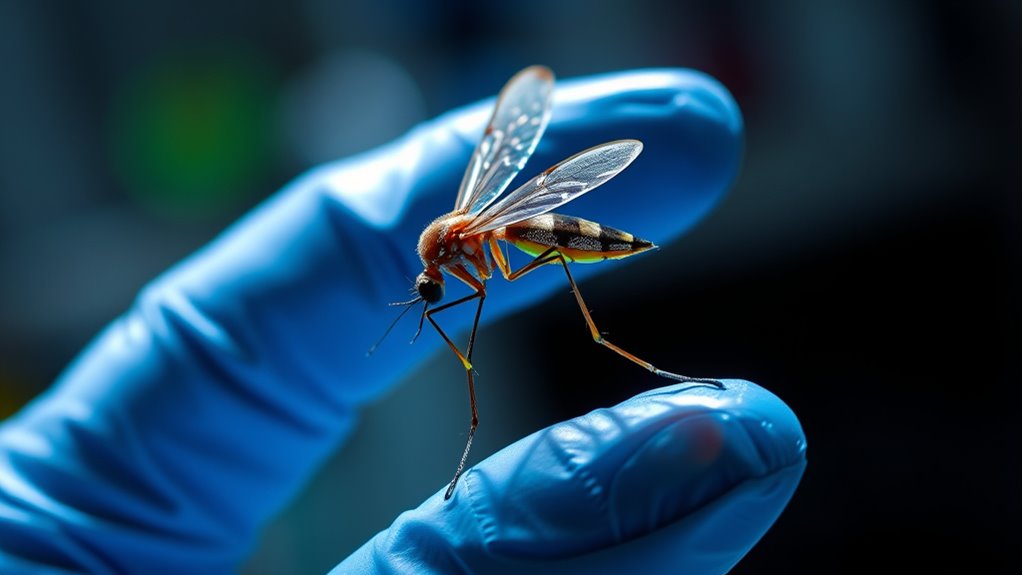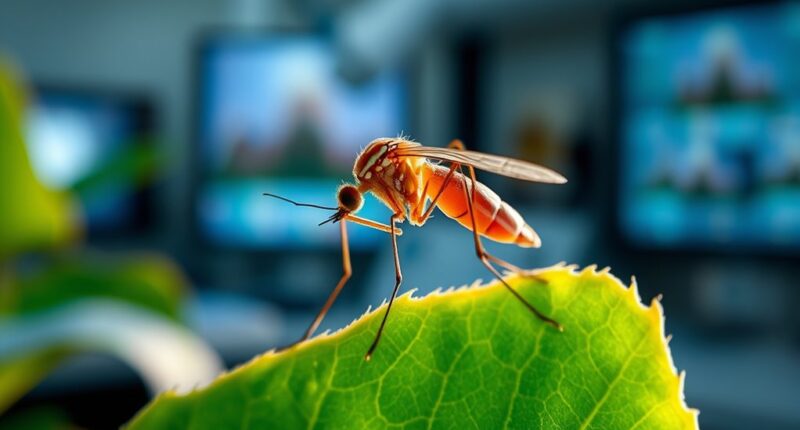Using CRISPR gene editing, scientists are making mosquitoes resistant to malaria or unable to reproduce, which could greatly cut disease transmission. This targeted approach offers high precision and could create self-sustaining populations with reduced ability to spread illness, all while lowering reliance on insecticides. It’s considered a groundbreaking and eco-friendly method that might revolutionize how we control malaria. Keep exploring to discover how this innovative strategy might transform public health efforts worldwide.
Key Takeaways
- CRISPR enables precise genetic modifications in mosquitoes to reduce their capacity to transmit malaria.
- Gene editing can create malaria-resistant mosquitoes, decreasing disease spread sustainably.
- Modified mosquitoes can pass beneficial genes through populations, offering a long-term control solution.
- This approach reduces reliance on insecticides, minimizing environmental impact.
- Ethical and ecological assessments are essential to ensure safety and effectiveness of gene-edited mosquitoes.

Have you ever wondered how scientists are using gene editing to combat mosquito-borne diseases? It’s a groundbreaking approach that’s transforming disease control efforts worldwide. By harnessing the power of gene editing technologies like CRISPR, researchers can modify mosquito genomes in precise ways to reduce or eliminate their ability to spread deadly illnesses like malaria. This innovative strategy targets the mosquito’s genetic makeup directly, aiming to disrupt the lifecycle of the disease-causing parasites they carry. Instead of relying solely on insecticides or traditional methods, gene editing offers a more sustainable and targeted solution, potentially reducing mosquito populations or rendering them incapable of transmitting pathogens.
The process involves identifying key genes responsible for the mosquito’s ability to carry malaria parasites. Scientists then use CRISPR to edit these genes, either disabling them or inserting new genetic traits that diminish the mosquito’s capacity to transmit the disease. For example, they might insert a gene that causes offspring to be sterile or that makes the mosquitoes resistant to the malaria parasite. These modifications are designed to spread through mosquito populations over time, leading to a significant decline in disease transmission. This approach offers a powerful tool for disease control because it directly targets the vector responsible for spreading illness, rather than just treating the symptoms or the infected individuals.
One of the most promising aspects of gene editing for disease control is its precision. Unlike older methods that relied on broad-spectrum insecticides, CRISPR allows scientists to make specific changes without harming other species or the environment. This precision reduces ecological risks and increases the likelihood of success. Furthermore, gene-edited mosquitoes can be self-sustaining once released, as they pass on their modified genes to subsequent generations. This means fewer interventions are needed over time, making the strategy both cost-effective and scalable.
However, deploying gene-edited mosquitoes also raises important ethical and ecological questions. Scientists, policymakers, and communities must work together to assess the risks and benefits thoroughly. Despite these concerns, the potential to drastically cut down malaria cases and save millions of lives makes this technology a game changer. As research advances, gene editing stands out as an innovative, targeted approach to disease control that could reshape how we combat mosquito-borne illnesses in the future.
Frequently Asked Questions
How Long Will CRISPR Mosquitoes Remain Effective in the Wild?
You wonder how long CRISPR mosquitoes stay effective in the wild. Their effectiveness depends on genetic stability and mutation rates; if they maintain stability, they could remain functional for several generations. However, higher mutation rates might cause them to lose their gene edits faster. Continuous monitoring and updates are necessary, as environmental factors and natural genetic variation can influence their longevity and impact in the ecosystem.
Are There Risks of CRISPR Mosquitoes Affecting Non-Target Species?
Coincidences often highlight the unpredictability of our actions. When considering CRISPR mosquitoes, you must ask if they pose risks to non-target species, especially regarding ecological impacts and biodiversity concerns. You might worry that gene edits could inadvertently affect other insects or animals, disrupting ecosystems. While scientists aim to minimize these risks, ongoing monitoring and thorough assessments are essential to safeguard biodiversity and prevent unintended ecological consequences.
What Are the Ethical Considerations of Releasing Genetically Modified Mosquitoes?
You should consider the ethical implications of releasing genetically modified mosquitoes, especially regarding genetic privacy and ecological balance. You might worry about unintended effects on ecosystems or the potential for genetic data misuse. Releasing these mosquitoes could disrupt local biodiversity or lead to unforeseen consequences. It’s essential to weigh the benefits against risks, ensuring transparency and community engagement to address ethical concerns responsibly and protect both environmental and genetic integrity.
How Much Does Developing and Deploying CRISPR Mosquitoes Cost?
You should consider that developing and deploying CRISPR mosquitoes involves a complex cost analysis, which includes research, testing, and distribution expenses. These costs can range from a few million to over $20 million, depending on project scope. Funding sources like government grants, private investments, and international health organizations help support these efforts. While expensive, the potential to dramatically reduce malaria makes it a worthwhile investment.
Can CRISPR Mosquitoes Help Eliminate Other Mosquito-Borne Diseases?
You might wonder if CRISPR mosquitoes can help eliminate other mosquito-borne diseases. The answer is yes; by using genetic crossover techniques, you can modify mosquitoes to reduce disease transmission of illnesses like dengue and Zika. This approach targets the mosquito’s ability to carry and spread pathogens, ultimately decreasing disease spread. CRISPR technology offers a promising way to control multiple diseases simultaneously, improving overall public health efforts.
Conclusion
As you consider the power of CRISPR mosquitoes, one thing is clear: we’re on the brink of a revolution in combating malaria. But the question remains—will these genetic changes hold or lead to unforeseen consequences? The future of disease control hangs in the balance, and your choices today could determine whether this breakthrough becomes a weapon or a warning. Stay vigilant—what happens next could change everything you thought you knew about fighting malaria forever.










